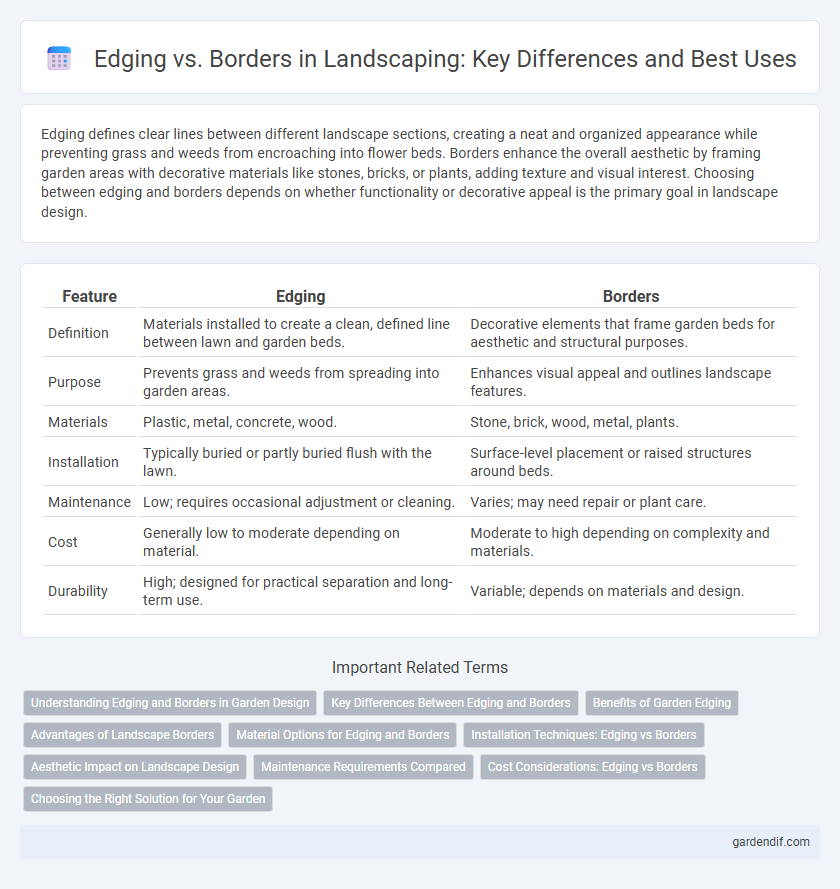
Edging vs Borders Illustration
Edging defines clear lines between different landscape sections, creating a neat and organized appearance while preventing grass and weeds from encroaching into flower beds. Borders enhance the overall aesthetic by framing garden areas with decorative materials like stones, bricks, or plants, adding texture and visual interest. Choosing between edging and borders depends on whether functionality or decorative appeal is the primary goal in landscape design.
Table of Comparison
| Feature | Edging | Borders |
|---|---|---|
| Definition | Materials installed to create a clean, defined line between lawn and garden beds. | Decorative elements that frame garden beds for aesthetic and structural purposes. |
| Purpose | Prevents grass and weeds from spreading into garden areas. | Enhances visual appeal and outlines landscape features. |
| Materials | Plastic, metal, concrete, wood. | Stone, brick, wood, metal, plants. |
| Installation | Typically buried or partly buried flush with the lawn. | Surface-level placement or raised structures around beds. |
| Maintenance | Low; requires occasional adjustment or cleaning. | Varies; may need repair or plant care. |
| Cost | Generally low to moderate depending on material. | Moderate to high depending on complexity and materials. |
| Durability | High; designed for practical separation and long-term use. | Variable; depends on materials and design. |
Understanding Edging and Borders in Garden Design
Edging in garden design refers to the material or method used to define boundaries between different landscape areas, such as separating lawns from flower beds, while borders typically describe the broader planting areas that frame paths or structures, often filled with shrubs, flowers, or decorative plants. Effective edging provides a clean, physical delineation that helps maintain garden structure and prevents grass intrusion into garden beds, enhancing visual appeal and reducing maintenance. Borders contribute to garden aesthetics by creating layers of texture and color, improving biodiversity, and guiding movement through outdoor spaces.
Key Differences Between Edging and Borders
Edging defines the precise lines between different landscape elements, typically using materials like metal, plastic, or stone to create clean separations. Borders focus on enhancing visual appeal and planting zones, often consisting of flower beds, shrubs, or decorative elements that frame an area. Edging offers functional containment and maintenance benefits, while borders prioritize aesthetic impact and garden design.
Benefits of Garden Edging
Garden edging enhances landscape design by clearly defining planting areas, preventing soil erosion, and reducing weed growth. It creates a polished appearance while facilitating easier lawn maintenance and protecting plants from damage. Durable materials like metal, stone, or plastic offer long-lasting performance and adaptability to various garden styles.
Advantages of Landscape Borders
Landscape borders enhance garden aesthetics by clearly defining planting areas, creating a polished and organized appearance. They prevent soil erosion and mulch displacement, maintaining healthy plant roots and reducing maintenance efforts. Durable materials used for borders also provide long-lasting protection against weed intrusion and lawn encroachment.
Material Options for Edging and Borders
Landscape edging and borders offer diverse material options tailored to enhance garden design and functionality. Popular materials for edging include metal, plastic, and rubber, prized for their flexibility, durability, and ease of installation to define lawn edges and prevent soil erosion. Border materials range from natural stone, brick, and concrete to wood, each providing unique aesthetic appeal and structural support to garden beds and pathways.
Installation Techniques: Edging vs Borders
Edging installation techniques typically involve embedding flexible or rigid materials like plastic, metal, or stone directly into the soil to create a clear, low-profile boundary that prevents grass and plants from spreading. Border installation often uses raised or decorative elements such as bricks, pavers, or wood placed above ground level, requiring secure anchoring methods like stakes or mortar for stability. Proper selection of installation techniques depends on landscape design goals, soil type, and maintenance preferences to ensure durability and aesthetic appeal.
Aesthetic Impact on Landscape Design
Edging creates clean, defined lines that enhance the visual structure of garden beds, while borders add depth and texture through varied materials like stones or plants. The choice between edging and borders significantly influences the aesthetic harmony, with edging providing a minimalist, modern appeal and borders offering a more natural, layered look. Both techniques guide the eye and frame outdoor spaces, shaping the overall landscape design impact.
Maintenance Requirements Compared
Edging typically requires frequent trimming and realignment to maintain clean lines, especially in high-traffic areas, while borders demand less regular upkeep but may need occasional weeding or resetting of materials such as bricks or stones. Borders often provide a more durable and long-lasting solution with minimal maintenance, as they create a physical barrier that reduces grass encroachment and soil erosion. Choosing between edging and borders depends on the desired aesthetic, budget, and willingness to commit to ongoing maintenance efforts.
Cost Considerations: Edging vs Borders
Edging typically costs less upfront due to lower material and installation expenses, making it a budget-friendly option for defining garden beds or pathways. Borders, often made from more durable and decorative materials like stone, brick, or metal, involve higher initial investment but offer enhanced longevity and aesthetic appeal. Evaluating long-term maintenance costs and landscape design goals helps determine whether edging's affordability or borders' durability provides better value.
Choosing the Right Solution for Your Garden
Choosing the right solution for your garden involves understanding the difference between edging and borders; edging offers a clean, precise line to separate lawn from garden beds, while borders provide a more decorative and functional boundary using materials like bricks, stones, or plants. Edging is ideal for low-maintenance gardens that require clear separation, whereas borders enhance aesthetic appeal and can serve as barriers to pests or invasive roots. Selecting the best option depends on your garden's style, maintenance level, and functional needs to create a cohesive outdoor space.
Edging vs Borders Infographic

 gardendif.com
gardendif.com